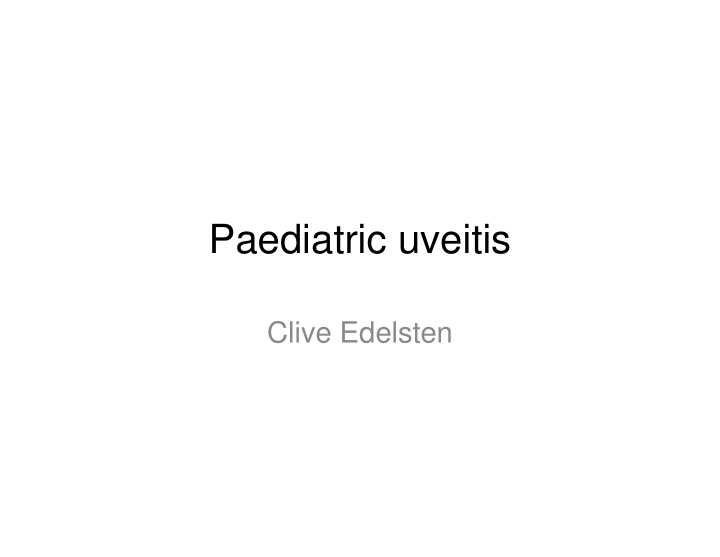



Paediatric uveitis Clive Edelsten
bio • MA,MB Bchir, Cambridge, UK 1983 • MRCP 1986, FRCS 1988 • Consultant ophthalmologist Ipswich Hospital 1996 • Consultant Ophthalmologist Great Ormond Street Hospital 1988 • Research Interests :epidemiology of ocular inflammatory disease; management of paediatric uveitis
Bio 2 • Member British Ophthalmological Surveillance Unit • Member ‘multinational outcomes in paediatric uveitis group’ • International observor for American Uveitis society meeting on ‘Guidelines for paediatric uveitis’ April 2011 • Principal investigator for ophthalmology section ‘childhood arthritis prospective study’[multicentre UK ]
Bio 3 • Co investigator: • 1. canakinumab in childhood CAPS. • 2. adalumimab in JIA-uveitis.
Size of the problem • The incidence of uveitis is 12-24/100,000 • Paediatric uveitis is usually 5% of cases. • Incidence of uveitis rises continuously till mid 40s
Type of paediatric uveitis • HLA-B27 AAU is commonest in adults and v rare in children • JIA does not occur in adults • Sarcoid and MS and Behcet’s peak in 20s to 40s • Uveitis syndromes eg birdshot ] are v rare in children
Types of paediatric uveitis • Idiopathic – JIA like uveitis – Others • Intermediate uveitis • More benign chronic anterior uveitis • Multifocal choroiditis • JIA-uveitis
Outcomes • Mostly painless-so late presentation • Children present with one eye already blind at a far higher frequency • JIA is a very chronic disease • Genetic causes lead to chronicity
Prevalence of second line immunosuppression • Population based survey • 15 year prevalence of IMT prescribed in all uveitis is 7/100,000 • 35% of these are children • = 1500 children on IMT in UK in last 15 years • 200 at GOS
Problems of extrapolating from adult uveitis • Paucity of information about adults from trials of licensed medications • JIA and uveitis is not the same as ERA and uveitis • Greater severity of visual loss at presentation means different cost/benefit analysis • Greater risk of visual loss and therefore lifelong handicap means different social cost
Treatment costs • Steroids and growth-side effect profile is lifelong • Oral versus injection –tolerability • Blood monitoring-tolerability • Topical steroid costs lead to lifelong problems with cataract and glaucoma
Longer perspective required for safety • Parental consent to trials greatly influenced by very long-term safety • Very long term safety more important in children and less available • Ciclosporin and late renal failure • Skin cancer with aza and ciclo • Tb/malignancy with anti-TNF MoAb
Measuring children • Acuity is mood and age dependent • Amblyopia confounds outcomess • Limited imaging possible • Severe disease prevents some monitoring • Clinical exam is mood dependent
Endpoints • Blindness is likley to be shared between patients, parents and doctors • But visual loss in unilateral amblyopes is of low value to patient • Treatment costs are paramount to families for many years
Endpoints 2 • Immunosuppression must be able to reduce inflammation • Measures of inflammation used to monitor clinical decision making are different to those which – Are measurable objectively – Have low inter-observor variability – Are validated to predict permanent visual loss
Areas of no consensus • Relative value of AC cells and flare in JIA- u • Value of cells and flare and haze and cmo as continuous variables • Rates of remission/relapse may be simpler and more predictive of success/failure • Clinically significant rates of relapse , or lengths of remission need to be established
Groups involved • AUS • Multinational group • CAPS study • Two trials imminent
Recommend
More recommend